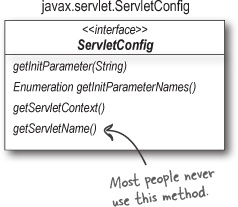Testing your ServletConfig
ServletConfig’s main job is to give you init parameters. It can also give you a ServletContext, but we’ll usually get a context in a different way, and the getServletName() method is rarely useful.

In the DD (web.xml) file:
<?xml version="1.0" encoding="ISO-8859-1"?> <web-app xmlns="http://java.sun.com/xml/ns/j2ee" xmlns:xsi="http://www.w3.org/2001/XMLSchema-instance" xsi:schemaLocation="http://java.sun.com/xml/ns/j2ee/web-app_2_4.xsd" version="2.4"> <servlet> <servlet-name>BeerParamTests</servlet-name> <servlet-class>com.example.TestInitParams</servlet-class> <init-param> <param-name>adminEmail</param-name> <param-value>likewecare@wickedlysmart.com</param-value> </init-param> <init-param> <param-name>mainEmail</param-name> <param-value>blooper@wickedlysmart.com</param-value> </init-param> </servlet> <servlet-mapping> <servlet-name>BeerParamTests</servlet-name> <url-pattern>/Tester.do</url-pattern> </servlet-mapping> </web-app>
In a servlet class:
package com.example; import javax.servlet.*; import javax.servlet.http.*; import java.io.*; public class TestInitParams extends HttpServlet { public void doGet(HttpServletRequest request, HttpServletResponse response) throws IOException, ServletException { response.setContentType("text/html"); PrintWriter out = response.getWriter(); out.println("test init parameters<br>"); java.util.Enumeration e = getServletConfig().getInitParameterNames(); ...Get Head First Servlets and JSP, 2nd Edition now with the O’Reilly learning platform.
O’Reilly members experience books, live events, courses curated by job role, and more from O’Reilly and nearly 200 top publishers.

